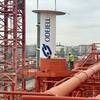Four 8600 TEU container ships contracted by Hyundai Merchant Marine Co Ltd (HMM) for building at Hyundai Heavy Industries Co Ltd (two ships) and Hyundai Samho Heavy Industries Co Ltd (two ships) in Korea are to be powered by 14-cylinder Sulzer RT-flex96C common-rail engines. Each engine will have a maximum continuous power of 80,080 kW (108,920 bhp).
These Sulzer 14RT-flex96C engines will be built under license from Wärtsilä Corporation by Hyundai Heavy Industries Co Ltd. The ships are due for delivery in the first quarter of 2008 and are intended for operation on the East Asia - Europe trade. They will have a service speed of 27 knots.
Mr J.S. Kwon, Senior Vice President of Hyundai Merchant Marine looked forward to the delivery of these ships, commenting, "The choice of 14-cylinder Sulzer engines with the latest common-rail technology provides us with a very economical propulsion plant for more than 100,000-horsepower."
The Sulzer 14RT-flex96C is the most powerful marine engine on order today, and also the first low-speed marine engine to be built with more than 12-cylinders.
Technical background
The Sulzer RT-flex96C is becoming a popular engine for the propulsion of large, fast container ships with some 101 engines of this type, with seven to 14 cylinders, now on order or already in service. The first RT-flex96C engines, with eight and 12 cylinders, entered service in November and December 2004 respectively.
The 14-cylinder RT-flex96C is an extended version of an already well-established 12-cylinder RT-flex96C design, which itself was developed from the Sulzer RTA96C engine type widely applied in container ships since 1998. Extensive consideration was, however, given to the practicality of the increased numbers of cylinders and to ensure that the engines match everyone's expectations in terms of safety, reliability and durability.
For, example, although there are numerous possibilities of firing orders for 14-cylinder engines, a firing order could be found with good vibration characteristics.
With regard to the engine structure itself, the opportunity had already been taken when adapting the structure to accommodate the RT-flex common-rail system, to introduce certain modifications in all cylinder numbers for better manufacture and which also resulted in greater stiffness and reduced stresses in the structure. The revision also took into account the 14-cylinder engines to ensure that they had adequate structural strength and rigidity without further modification.
While the crankshaft of the RT-flex96C has sufficient torque capacity for 14 cylinders, the material has been upgraded to enable an increased shrink fit for a greater design margin. The thrust bearing structure in RT-flex96C engines with a mid gear drive has been revised to reduce deformations and stresses even with the increased thrust in the 14-cylinder engine.
Sponsored Content
Experience Custom Yacht Signs and Designs Tailored to Perfection!

April 2025
 Read the Magazine
Read the Magazine

 Read the Magazine
Read the Magazine
This issue sponsored by:

Navigating the Future of the Maritime Industry
Subscribe for
Maritime Reporter E-News
Maritime Reporter E-News is the maritime industry's largest circulation and most authoritative ENews Service, delivered to your Email five times per week








